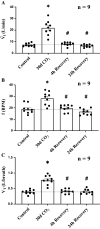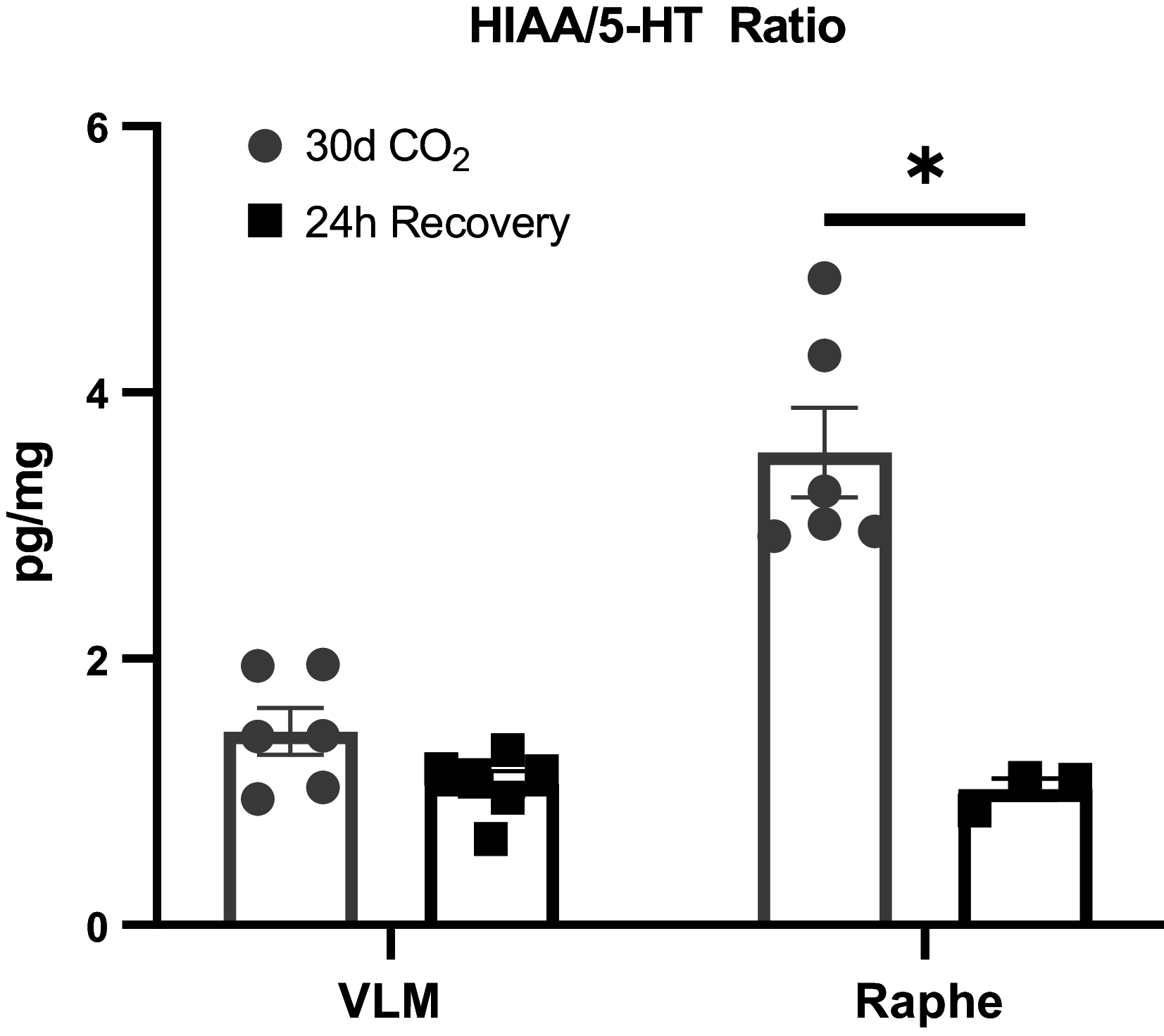Physiological and neurochemical adaptations following abrupt termination of chronic hypercapnia in goats
- PMID: 33539265
- PMCID: PMC8262788
- DOI: 10.1152/japplphysiol.00909.2020
Physiological and neurochemical adaptations following abrupt termination of chronic hypercapnia in goats
Abstract
Chronic hypercapnia (CH) is a hallmark of respiratory diseases such as chronic obstructive pulmonary disease. In such patients, mechanical ventilation is often used to restore normal blood-gas homeostasis. However, little is known regarding physiological changes and neuroplasticity within physiological control networks after termination of CH. Utilizing our goat model of increased inspired CO2-induced CH, we determined whether termination of CH elicits time-dependent physiological and neurochemical changes within brain stem sites of physiological control. Thirty days of CH increased [Formula: see text] (+15 mmHg) and steady-state ventilation (SS V̇i; 283% of control). Within 24 h after terminating CH, SS V̇i, blood gases, arterial [H+], and most physiological measurements returned to control. However, the acute ventilatory chemoreflex (ΔV̇i/Δ[H+]) was greater than control, and measured SS V̇i exceeded ventilation predicted by arterial [H+] and ΔV̇i/Δ[H+]. Potentially contributing to these differences were increased excitatory neuromodulators serotonin and norepinephrine in the nucleus tractus solitarius, which contrasts with minimal changes observed at 24 h and 30 days of hypercapnia. Similarly, there were minimal changes found in markers of neuroinflammation and glutamate receptor-dependent neuroplasticity upon termination of CH, which were previously increased following 24 h of hypercapnia. Thus, following termination of CH: 1) ventilatory, renal, and other physiological functions rapidly return to control; 2) neuroplasticity within the ventilatory control network may contribute to the difference between measured vs. predicted ventilation and the elevation in the acute ventilatory [H+] chemoreflex; and 3) neuroplasticity is fundamentally distinct from acclimatization to CH.NEW & NOTEWORTHY In healthy adult goats, steady-state ventilation and most physiological measures return to control within 24 h after termination of chronic hypercapnia (CH). However, the acute [H+] chemoreflex is increased, and measured ventilation exceeds predicted ventilation. At 24 h of recovery, excitatory neuromodulators are above control, but other measured markers of neuroplasticity are unchanged from control. Our data suggest that CH elicits persistent physiological and neurochemical changes for up to 24 h after termination of CH.
Keywords: deacclimatization; hypercapnia; neuromodulation; ventilatory control.
Figures







Similar articles
-
Chronic moderate hypercapnia suppresses ventilatory responses to acute CO<sub>2</sub> challenges.J Appl Physiol (1985). 2022 Nov 1;133(5):1106-1118. doi: 10.1152/japplphysiol.00407.2022. Epub 2022 Sep 22. J Appl Physiol (1985). 2022. PMID: 36135953 Free PMC article.
-
Ventilatory and integrated physiological responses to chronic hypercapnia in goats.J Physiol. 2018 Nov;596(22):5343-5363. doi: 10.1113/JP276666. Epub 2018 Oct 14. J Physiol. 2018. PMID: 30211447 Free PMC article.
-
Brainstem serotonergic, catecholaminergic, and inflammatory adaptations during chronic hypercapnia in goats.FASEB J. 2019 Dec;33(12):14491-14505. doi: 10.1096/fj.201901288RR. Epub 2019 Oct 31. FASEB J. 2019. PMID: 31670983 Free PMC article.
-
How important is the CO2 chemoreflex for the control of breathing? Environmental and evolutionary considerations.Comp Biochem Physiol A Mol Integr Physiol. 2018 Jan;215:6-19. doi: 10.1016/j.cbpa.2017.09.015. Epub 2017 Sep 29. Comp Biochem Physiol A Mol Integr Physiol. 2018. PMID: 28966145 Review.
-
Submissive hypercapnia: Why COPD patients are more prone to CO2 retention than heart failure patients.Respir Physiol Neurobiol. 2015 Sep 15;216:86-93. doi: 10.1016/j.resp.2015.03.001. Epub 2015 Apr 17. Respir Physiol Neurobiol. 2015. PMID: 25891787 Free PMC article. Review.
Cited by
-
Mild and moderate chronic hypercapnia elicit distinct transcriptomic responses of immune function in cardiorespiratory nuclei.Physiol Genomics. 2023 Nov 1;55(11):487-503. doi: 10.1152/physiolgenomics.00038.2023. Epub 2023 Aug 21. Physiol Genomics. 2023. PMID: 37602394 Free PMC article.
-
Chronic moderate hypercapnia suppresses ventilatory responses to acute CO<sub>2</sub> challenges.J Appl Physiol (1985). 2022 Nov 1;133(5):1106-1118. doi: 10.1152/japplphysiol.00407.2022. Epub 2022 Sep 22. J Appl Physiol (1985). 2022. PMID: 36135953 Free PMC article.
References
Publication types
MeSH terms
Substances
Grants and funding
LinkOut - more resources
Full Text Sources
Other Literature Sources

